Conservation Technologies for Geo-Environment
Outline of the Research
Recently, the environmental problems by outflow of soils has been actualizing. For example, marine damages such as the death of coral by outflow of red soils in Okinawa Pref., the damages of sewage facilities and collapse of the bank by liquefaction of the ground by earthquake etc. are becoming serious problems. Takahashi laboratory is carrying out the new developing research on environmental preservation type geo-recycling engineering aiming these problems solving.
Recent Research Topics
- (1) Environmental Preservation Type Improvement Technology to Reduce the Marine Damage by Outflow of Red Soils
- (2) Optimum Remediation System for Contaminated Soils by Volatile Organic Compound by Mixing and Agitating the Quicklime
- (3) DEM Simulation on Remediation of Contaminated Soils by Soil Improvement Machine
- (4) Reclamation of Unused Storage Pond by Fiber-Cement-Stabilized Soil Method
- (5) Application of Fiber-Cement-Stabilized Soil Method to the Treatment of Mud/Sludge Generated at Disaster Sites
(1) Environmental Preservation Type Improvement Technology to Reduce the Marine Damage by Outflow of Red Soils
The outflow of red-soil has been a serious problem in Okinawa prefecture in Japan since 1950. In Okinawa prefecture, the red-soil which covers the islands of Okinawa flows out from the surface of the ground when it rains. Consequently, it was caused that marine life such as the reef was dead or decreased. Furthermore, the tourist business is also damaged in Okinawa prefecture. If the fiber-cement-stabilized soil method is applicable to the red-soil, it can be considered that the red-soil will be improved to the highly-functional soil having high durability for drying and wetting and high resistance for gully erosion. Therefore, Takahashi laboratory is carrying out the experimental study to investigate the optimum operating conditions to apply the fiber-cement-stabilized soil method to the red-soil. We are now continuing the research to develop the planting soil by using red-soil having high resistive ability for heavy winds and rains like typhoon.
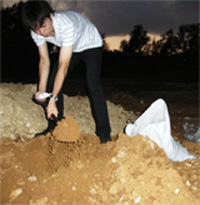
Sampling of red-soil(Okinawa, Japan)
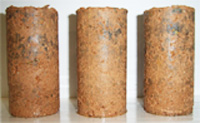
Fiber-cement-stabilized soils after drying and wetting cyclic tests
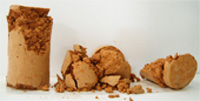
Conventional Cement-stabilized soils after drying and wetting cyclic tests
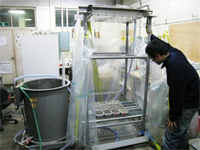
Experiment on receptivity for rainfall by using an artificial rainfall equipment
(2) Optimum Remediation System for Contaminated Soils by Volatile Organic Compound by Mixing and Agitating the Quicklime
One of the remediation methods for volatile organic compound is a Hot Soil Method. This method is to mix the contaminated soils and quicklime to increase the temperature of the soil. The volatile organic compound evaporates and contaminated soils are cleaned up. When this Hot Soil Method is carried out by using a mobile soil recycling machine, the optimum operating conditions are not made clear yet. Therefore, we are studying the relationship between disincentives for remediation and physical properties of soils agitated by the machine, and the optimum operating conditions of mobile soil-recycling machine. We have already clarified the effects of porosity of the soil, soil particle diameter, packing height, water content on the soil on remediation of the contaminated soils.
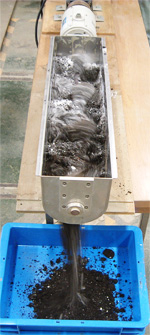
Remediation of contaminated soils by VOC
by using a mobile soil-recycling machine
(3) DEM Simulation on Remediation of Contaminated Soils by Soil Improvement Machine
Recently, a soil mixing machine has been receiving considerable attention in order to restore the contaminated soils. In the remediation sites, contaminated soils are fed into the machine and they are mixed with the liquid agent. As the liquid agent is expensive, it is necessary to obtain the mixing behavior of contaminated soils and agent, and to know the optimum operating condition in order to perform the effective remediation. However, many parameters affect the mixing behavior and experimental investigation is uneconomical and ineffective.
In this study, the mixing of contaminated soils and liquid agent was simulated by using distinct element method(DEM). In the DEM simulation, the increase of water content due to the addition of liquid agent was simulated and this result was compared with the experimental one. It was confirmed through the comparison that the model proposed here was almost reasonable.
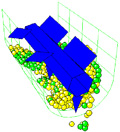
An example of simulation results
(4) Reclamation of Unused Storage Pond by Fiber-Cement-Stabilized Soil Method
The Haga pond in Koriyama city had the intense bad smell by aggravation of water quality and sedimentation of sludge, and a complaint did not cease from peripheral people. Therefore, Koriyama city conducted the construction work to dredge the sludge deposited at the bottom of Haga pond, and to build the water park in 2004. In this construction work, a large amount of sludge were discharged, but all of them were recycled as the base materials of the water park. The pictures show the Haga pond before and after the construction. Now, there is no bad smell, water becomes clean, and remarkable effects that fishes return to the pond are recognized. We are thinking that such a construction is a eco-friendly construction and a prime example of environmental geotechnical recycling engineering. Takahashi laboratory is carrying out the recycling research with the viewpoint "A construction by-product is not waste but a precious material." We are aiming at establishment of "environmental geotechnical recycling engineering" so that it may be useful to construction of the recycling based society which is also a national policy.
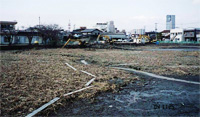
Haga pond before construction (Koriyama city, Japan)
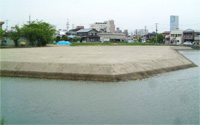
Haga pond after construction (Koriyama city, Japan)
(5) Application of Fiber-Cement-Stabilized Soil Method to the Treatment of Mud/Sludge Generated at Disaster Sites
Recently, serious natural disasters such as Niigata Chuetsu earthquake in 2004 and flood damage in Kyushu/Shikoku district in 2005 have occurred successively. In these cases, the hindrance of early disaster restoration is the mud which is liquefied according to the earthquake and large amount of weak soils generated by the landslide and river channel blockade. It is very hard to ensure the roads for vehicles and construction machines to enter the disaster sites due to the generation of mud, and it interferes with early disaster restoration. In Niigata Chuetsu earthquake in 2004, Imogawa river channel blockage occurred by the landslide, and a large amount of mud generated. The fiber-cement-stabilized soil method was adopted in the urgent countermeasure construction work for Imogawa river channel blockage, and a large amount of high water content mud was recycled by this method and was used as the road construction for vehicles and construction machines. In this way, it was confirmed that our recycling method for high water content mud was applicable for the disaster restoration sites. We are studying the research on application of fiber-cement-stabilized soils method to the disaster restoration spot is advanced.
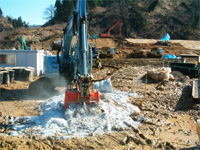
The fiber-cement-stabilized soil method was adopted in the urgent countermeasure construction work for Imogawa river channel blockage.
